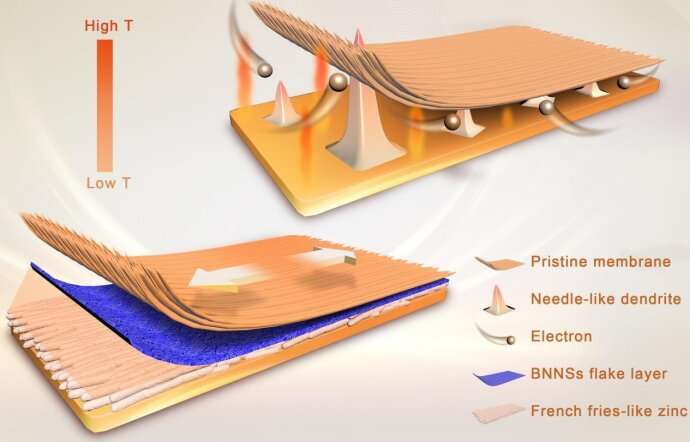Credit: University of Science and Technology of China
The bipolar membrane, a type of ion exchange membrane, is considered the pivotal material for zero emission technology. It is composed of an anode and cathode membrane layer, and an intermediate hydrolysis layer. Under reverse bias, the water molecules in the intermediate layer produce OH- and H+ by polarization.
Large-scale production of the membrane is hindered by the different expansion coefficients of the anode and cathode layers, causing the two layers easy to delaminate. Besides, the mostly used intermediate catalysts are small molecules or transition, which are instable and inefficient.
In a study published on Nature Communications, a team led by Prof. Xu Tongwen and Prof Wu Liang from the University of Science and Technology of China (USTC) of the Chinese Academy of Sciences (CAS) adopted an in-situ growth idea to construct a stable and efficient membrane.
In their previous studies on bipolar membranes, the researchers have developed the anode and cathode membrane layer of polyphenylene ether substrate to solve the problem of different expansion coefficients, and prepared a series of intermediate catalytic layer structures to address the second problem. However, for the industrial application, further research is needed as the hydrolysis pressure drop are too high for large scale production.
Therefore, the researchers constructed a stable hydrolysis intermediate layer by regulating the in-situ growth position at the anode and cathode membrane interface, aniline molecules aggregated, polymerized, and encapsulated FeO(OH) particles.
The polyaniline network provides strong adhesion between the membrane layers and realizes the fixation and uniform dispersion of FeO(OH) particles. FeO(OH) particles of uniform size provide active sites for hydrolysis and promote water polarization, releasing H+ and OH- quickly under an electric field.
This newly synthesized membrane outperforms the corresponding Japanese commercial membrane Neosepta BP1 in the aspects of starting voltage of water dissociation, stability at high current density and ability to generate acid and alkali by hydrolysis.
Furthermore, the researchers developed molding techniques with independent intellectual property rights. The large-scale production line is under construction.
More information: Muhammad A. Shehzad et al, Shielded goethite catalyst that enables fast water dissociation in bipolar membranes, Nature Communications (2021). DOI: 10.1038/s41467-020-20131-1
Journal information: Nature Communications
Provided by University of Science and Technology of China
























